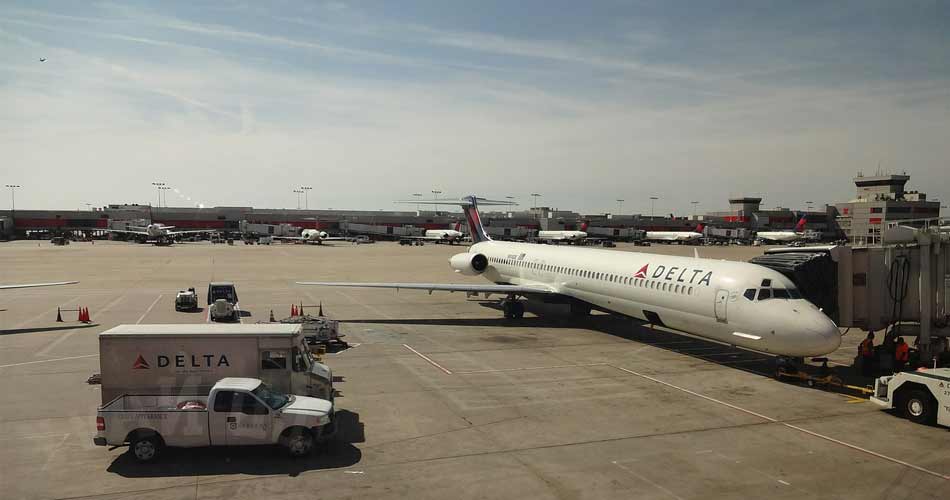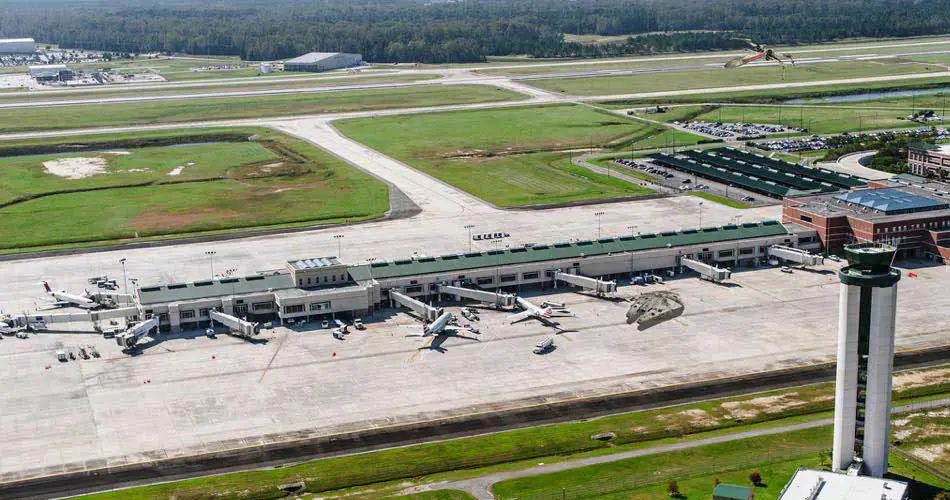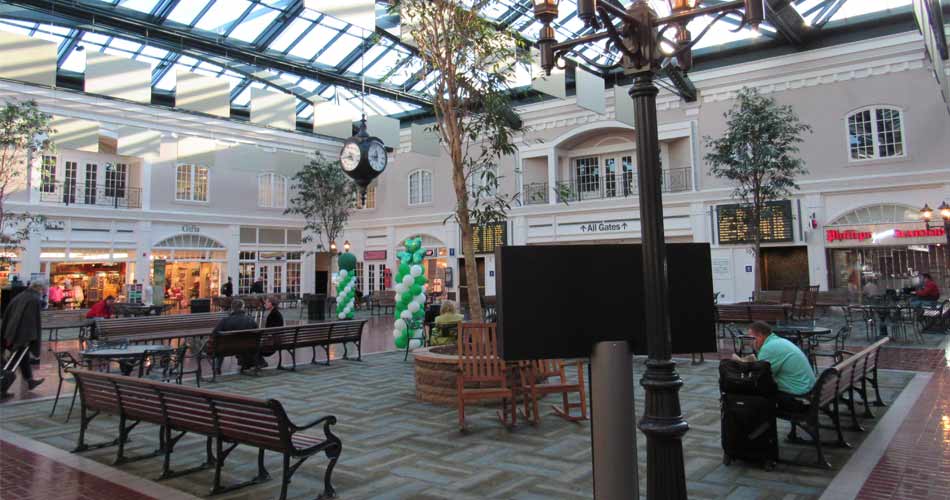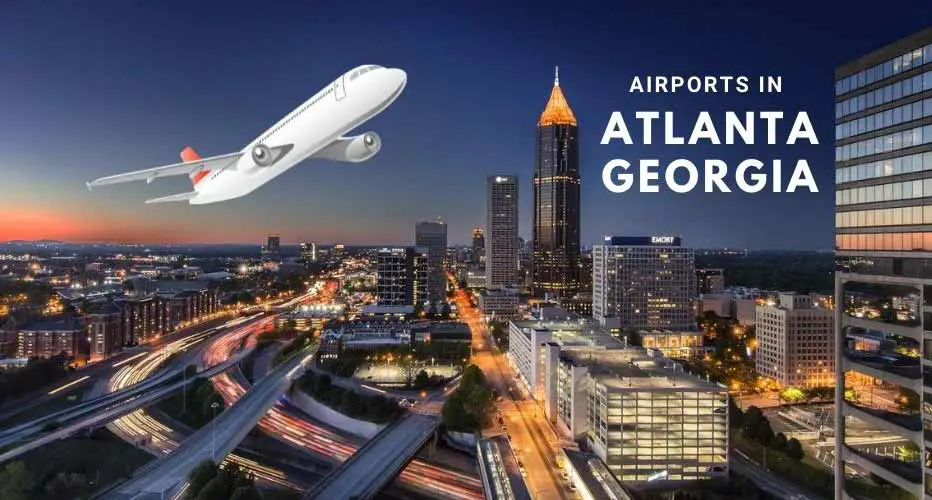There are two major international airports in Georgia Atlanta; Hartsfield-Jackson Atlanta International Airport and Savannah/Hilton Head International Airport.
We will explore Hartsfield-Jackson Atlanta International Airport and Savannah Airport in detail. Also, don’t forget to visit the end section as we will also explore all other airports in Georgia Atlanta.
Table of Contents
Major Airports in Georgia Atlanta
Georgia’s Atlanta area is home to two major airports:
The Hartsfield–Jackson Atlanta International Airport (ATL) takes the crown as the world’s busiest airport when it comes to the number of people flying through. It’s just 10 miles (16 km) south of downtown Atlanta.
The Savannah/Hilton Head International Airport (SAV), located in Savannah, Georgia, comes in second place in terms of traffic in the state. This airport is a popular choice for those heading to Georgia’s coastal areas.
Let’s explore these airports in detail.
Hartsfield-Jackson Atlanta International Airport (ICAO: KATL, IATA: ATL, FAA LID: ATL)
Hartsfield-Jackson Atlanta International Airport is the major airport operating in Atlanta, Georgia. The airport situated at an elevation of 1,026 ft (313 m) covers an area of 4,700 acres (1,902 ha) of land. The exact location of the airport is 7 miles south of the Downtown Atlanta district.
The name ‘Hartsfield-Jackson’ is named after former mayors of Atlanta Mr. William B. Hartsfield and Maynard Jackson. The Atlanta airport became the world’s busiest airport from 1998 to 2019 in terms of passenger movement however, the title was lost in 2020 following the adverse impact of the COVID-19 pandemic. The Guangzhou Baiyun International Airport became the busiest airport due to the downfall of Atlanta Airport.
The Atlanta International Airport features 5 runways with a minimum length of 9,000 ft and is home to Delta Air Lines. It also contains a helipad with a length of 52 ft (17m). Over 1,000 daily flights are operated to and from the airport to almost 225 domestic and international destinations.
Atlanta International Airport History
The history of Hartsfield-Jackson Atlanta International Airport began on April 16, 1925, when city Mayor Walter A. Sims signed a five-year lease on an abandoned auto racetrack to build an airfield. With the agreement, 287 acres of land were acquired for Candler Field and used as a landing site.
The first commercial flight was conducted on 15th September 1926 as Florida Airways delivered mail on the Tampa/Jacksonville/Atlanta route. Likewise, Pitcairn Aviation (now Eastern Airlines) initiated scheduled regular air service in the Candler airfield. This was an airmail provider company.

On April 13, 1929, Atlanta City paid an amount of US$94,400 for the land and changed the name ‘Candler Field’ to ‘Atlanta Municipal Airport’. Delta Air Service now known as Delta Air Lines started a trial service from Birmingham, Alabama on 12th June 1930 and later made it a permanent route on 18th June.
Eastern Air Transport (previously known as Pitcairn Aviation) embarked first continuous passenger flights from Atlanta to New York on 10th December 1930. On July 4, 1934, the airport established a new connection after Delta Air Lines re-started Ft. Worth-Atlanta route.
One of the major achievements of the airport was the opening of the first-ever control tower in March 1939. The U.S. government declared Atlanta airport an airbase in October 1940 and Delta Air Service transferred its headquarters from Monroe, Louisiana, to Atlanta.
Atlanta Municipal Airport got the title of the nation’s busiest airport in terms of flight operation in 1942 after recording 1,700 takeoffs and landings in a single day. Over 1 million passengers movement was recorded in the year 1948.
Atlanta Airport became the busiest airport in the United States with over 2 million passengers using the service in the year 1957. The airport also became the world’s busiest airport in the category of flights recorded between noon and 2 pm each day. Due to the congestion, a new terminal development project was initiated.
The greatest revolution happened at the airport on 3rd May 1961 after the inauguration of the largest single terminal in the whole of the United States. The all-new US$21 million infrastructure was capable of accommodating over 6 million passengers each year. More than 9 million travelers passed through the airport in the first year. With that, the Atlanta Municipal Airport progressed into the ‘Jet era’.
The Atlanta Region Metropolitan Planning Commission (ARMPC) executed the first-ever formal planning studies to propose the mid-field terminal concept in 1964.
With the death of Mayor William B. Hartsfield on 22nd February 1971, the name of the airport was changed to William B. Hartsfield Atlanta Airport. The name was again revised to William B. Hartsfield Atlanta International Airport after the initiation of flights to Mexico and Montego Bay by Eastern Airlines. This was the first-ever international service operated at the airport.
The US$500 million project on the world’s largest terminal complex began in the airport in January 1977. A foreign international airline named Sabena Belgian World Airlines became the first foreign carrier to operate flights to and from the Atlanta Airport. The airline started commercial passenger flights on 1st June 1978 operating four-time a week and connecting two major cities; Brussels, and Atlanta.
The World’s largest air passenger terminal complex was inaugurated on September 21, 1980, and covered a whopping area of 2.5 million square feet. The terminal was built to facilitate almost 55 million passengers yearly.
The airport saw more development with a new 9,000-foot fourth parallel runway built in December 1984. The runway was later expanded to 11,889 feet to handle the largest commercial aircraft. The Atlanta Airport got connected with the rapid transit system after the opening of MARTA’s Airport Station on June 18, 1988.

The single and largest international facility was opened with a new 1.3 million-square-foot International Concourse E. This concourse was developed with state-of-the-art technology, innovative design, distinctive art, pleasant amenities, and impressive architectural design to offer quick and smooth service to international passengers.
To make the Hartsfield Airport user-friendly and advanced, the US$250 million Hartsfield Improvement Program (HIP) was completed in May 1996. A three-storeyed 250,000 square-foot Atrium was also added to the airport infrastructure.
The new Master Plan named ‘Hartsfield-2000 and Beyond’ was initiated by the Department of Aviation in June 1996. In February 1999, Hartsfield Airport received the title ‘World’s Busiest Airport’ in terms of passenger volume after serving almost 74 million air travelers in 1998.
The Hartsfield Airport gained the title of the busiest airport in the world in terms of both passenger movement and the number of landings and takeoffs in 1999. This title was achieved following the movement of over 78 million passengers and more than 900,000 landings and takeoffs.
Fifth-runway was built at the airport in April 2001 under the 10-year capital improvement program with an estimated budget of over US$6 billion.
The name ‘Hartsfield-Jackson Atlanta International Airport’ was finalized in October 2003 to honor the late Mayor Maynard H. Jackson and also respect the visionary leadership of Mayor William B. Hartsfield and Maynard Jackson for developing the airport.
After celebrating its 80th birthday in July 2005, the airport opened its fifth runway in May 2006 which was termed as ‘The Most Important Runway in the United States. More titles were given to the airport in January 2007 including ‘Best Large U.S. Airport by American Express’ Executive Traveler Magazine, and Most Efficient Airport in the World by Air Transport Research Society.
The airport retained the title of ‘World’s Busiest Airport’ for 15 consecutive years. In September 2013, Hartsfield-Jackson Airport welcomed the arrival of the world’s largest passenger aircraft Airbus A380 owned by Korean Air.
The airport became successful in setting a record of holding ‘World’s Busiest Airport’ for 22 consecutive years after getting awarded in the year 2019.
Facilities at the Hartsfield-Jackson Atlanta International Airport

Terminal Facility
The Atlanta International Airport features two terminals and seven concourses with a total of 195 gates. The international terminal is located on the eastern section of the airport whereas the domestic terminal is placed on the western side.
A pedestrian tunnel ‘Transportation Mall’ connects the terminals and concourses with moving walkways and the plane train (automated people mover).
| CONCOURSE | GATES | AIRLINES SERVICE |
| T | 17 | Delta Sky Club, American Admiral’s Club, United Club |
| A | 29 | Delta Sky Club |
| B | 32 | Delta Sky Club |
| C | 34 | Delta Sky Club |
| D | 40 | Delta Sky Club |
| E | 28 | Delta Sky Club |
| F | 15 | Delta Sky Club, The Club |
Atlanta International Airport Runway Information
There are 5 runways available at the Hartsfield-Jackson Atlanta International Airport including RWY 8L/26R, 8R/26L, 9L/27R, 9R/27L, and RWY 10/28.
| RUNWAY | DIMENSION | EQUIPPED WITH |
| 8L/26R | 9,000 ft by 150 ft | Instrument Landing System (ILS) |
| 8R/26L | 9,999 ft by 150 ft | Instrument Landing System (ILS) |
| 9L/27R | 12,390 ft by 150 ft | Instrument Landing System (ILS) |
| 9R/27L | 9,000 ft by 150 ft | Instrument Landing System (ILS) |
| 10/28 | 9,000 ft by 150 ft | Instrument Landing System (ILS) |
Operating Airlines
| PASSENGER AIRLINES | CARGO AIRLINES |
| Air Canada Express Air France Alaska Airlines American Airlines American Eagle Boutique Air British Airways Copa Airlines Delta Air Lines Delta Connection Frontier Airlines JetBlue KLM Korean Air Lufthansa Qatar Airways Southwest Airlines Spirit Airlines Turkish Airlines United Airlines Virgin Atlantic WestJet | AeroLogic AirBridgeCargo Amazon Air Asiana Cargo ASL Airlines Belgium CAL Cargo Air Lines Cargolux Cathay Pacific Cargo China Airlines Cargo China Cargo Airlines DHL Aviation EVA Air Cargo FedEx Express Korean Air Cargo Lufthansa Cargo Qatar Airways Cargo Turkish Airlines Cargo UPS Airlines |

Busiest Domestic Routes from Atlanta Int’l Airport
| DESTINATION | OPERATING AIRLINES |
| Fort Lauderdale, Florida | Delta, JetBlue, Southwest, Spirit |
| Orlando, Florida | Delta, Frontier, JetBlue, Southwest, Spirit |
| Miami, Florida | American Airlines, Delta, Frontier |
| Denver, Colorado | Delta, Southwest, Spirit, Frontier, United |
| Tampa, Florida | Delta, Southwest, Spirit, Frontier |
| Los Angeles, California | American Airlines, Delta, Frontier, Southwest, Spirit |
| Dallas/Fort Worth, Texas | American Airlines, Delta, Spirit |
| Las Vegas, Nevada | Delta, Frontier, Southwest, Spirit |
| Detroit, Michigan | Delta, Spirit |
| Salt Lake City, Utah | Delta, Frontier |
Busiest International Destinations
| DESTINATION | OPERATING AIRLINES |
| Paris-Charles de Gaulle, France | Air France, Delta |
| Amsterdam, Netherlands | Delta, KLM |
| Toronto-Pearson, Canada | Air Canada, Delta |
| Cancun, Mexico | Delta, Southwest |
| London Heathrow, UK | British Airways, Delta, Virgin Atlantic |
| Seoul-Incheon, South Korea | Delta, Korean |
| Mexico City, Mexico | Delta, Southwest |
| Montego Bay, Jamaica | Delta |
| Nassau, Bahamas | Delta |
| Punta Cana, Dominican Republic | Delta |
Hartsfield-Jackson International Airport Technical Information
| ICAO Code | KATL |
| IATA Code | ATL |
| FAA LID | ATL |
| Elevation | 1,026 ft above mean sea level (313m) |
| Runway | 8L/26R (Concrete) 8R/26L (Concrete) 9L/27R (Concrete) 9R/27L (Concrete) 10/28 (Concrete) |
| Helipad | H2 (52 ft asphalt) |
Savannah/Hilton Head International Airport (ICAO: KSAV, IATA: SAV, FAA LID: SAV)
Savannah/Hilton Head International Airport is a commercial, as well as military-use airport situated at an elevation of 50 ft above mean sea level. The airport located 8 miles northwest of the Savannah Historic District is owned and operated by the Savannah Airport Commission
The airport features two concrete runways; RWY 10/28 and RWY 1/19.
History of Savannah/Hilton International Airport

The history of Savannah/Hilton International Airport began on September 20, 1929, with the introduction of Savannah Municipal Airport. This municipal airport facilitated the first air service between Miami and New York City operated by Eastern Air Express.
The Savannah city acquired a 600-acre tract located near Cherokee Hill to construct a new airfield under the Works Progress Administration project. Three runways each with a length of 3,600 feet were built in the direction north-south (N-S), east-west (E-W), and northeast-southwest (NE-SW).
The airport was acquired by the U.S. Army Air Corps in 1942 to initiate additional construction projects for military missions. The airfield was named ‘Chatham Field’ by the U.S. Army and was utilized till the end of the Second World War. The airfield was later named Travis Field in honor of Savannah native Brigadier General Robert F. Travis who died in the B-29 bomber crash near Fairfield-Suisun AFB, California.
The airfield got a new control tower and an airline terminal in the year 1948. A new terminal project began in 1958 whereas the east-west (E-W) runway’s length was extended to 9,000 feet in 1962.
Delta Air Lines began operating Douglas DC-9-10 at the airport which the jet era entered in 1965. A six-gate terminal constructed in 1960 was replaced by the new terminal building in 1994 built with an estimated budget of US$21 million.
The name of the airport was changed to ‘Savannah International Airport’ in 1983 and again to ‘Savannah/Hilton Head International Airport in 2003.
The airport operated international air service with nonstop flights to the Caribbean and Mexico with Key Airlines operating a hub. The airline operated flights with Boeing 727-100 and 727-20 to various destinations however, it ceased operation in 1993 following the financial crisis.
The new terminal with 275,000 sq. ft. space was opened in 1994 with eight gates. Likewise, the terminal expansion project was accomplished in July 2007 with the addition of five departure gates.
The international service at Savannah International Airport resumed in 2017 after Air Canada initiated seasonal service connecting Savannah and Toronto.
Savannah Airport Runway Information
Savannah/Hilton Head International Airport covers an area of 3,650 acres (1,477 ha) and features two concrete runways; RWY 10/28 and RWY 01/19.
| RUNWAY | LENGTH |
| RWY 10/28 | 9,351 ft (2,850 m) |
| RWY 1/19 | 7,002 ft (2,134 m) |

Airlines and Destinations
| AIRLINE | DESTINATIONS |
| Air Canada | Toronto |
| Allegiant Air | Allentown, Appleton, Baltimore, Bellville, Cincinnati, Chicago, Cleveland, Columbus, Grand Rapids, Houston, Indianapolis, Louisville, Nashville, Newburgh, Newark, Pittsburgh |
| American Airlines | Charlotte, Chicago O’Hare, Dallas, Laguardia, Miami, Philadelphia, Washington Reagan |
| Delta Air Lines | Atlanta, Detroit, New York JFK, New York LGA |
| Frontier Airlines | Philadelphia |
| JetBlue | Boston, New York, Ft. Lauderdale, Tampa |
| Southwest Airlines | Baltimore, Chicago, Dallas, Houston, Nashville, St.Louis, Denver |
| United Airlines | Chicago O’Hare, Denver, Houston, Milwaukee, Newark, Washington |
Savannah/Hilton Head International Airport ( Technical Information)
| ICAO Code | KSAV |
| IATA Code | SAV |
| FAA LID | SAV |
| Elevation | 50 ft above mean sea level (15 m) |
| Runway | RWY 10/28 (Concrete) RWY 1/19 (Concrete) |
Other airports in Georgia Atlanta
Atlanta South Regional Airport (ICAO: KHMP, FAA LID: HMP)
Atlanta South Regional Airport is among the airports in Georgia Atlanta and is located 6 km west of the central business district of Hampton, Henry County, Georgia.
| ICAO Code | KHMP |
| IATA Code | – |
| FAA LID | HMP |
| Elevation | 874 ft above mean sea level (266 m) |
| Runway | RWY 6/24 (5,500 ft Concrete) |
| Area | 160 acres |
Atlanta Regional Airport/Falcon Field (ICAO: KFFC, FAA LID: FFC)
Atlanta Regional Airport is also among the airports in Georgia Atlanta, situated at an elevation of 808 ft (246 m) in Fayette County, Georgia. The airport is 29 miles southwest of the central business district of Atlanta.
| ICAO Code | KFFC |
| IATA Code | – |
| FAA LID | FFC |
| Elevation | 874 ft above mean sea level (266 m) |
| Runway | RWY 13/31 (5,768 ft Asphalt) |
| Area | 350 acres |
Cherokee County Airport (ICAO: KCNI, FAA LID: CNI)
Cherokee County Regional Airport is located in Cherokee County, Georgia at an elevation of 1,219 ft (372m) above mean sea level. The airport is among the municipal airports in Georgia Atlanta.
| ICAO Code | KCNI |
| IATA Code | – |
| FAA LID | CNI |
| Elevation | 1,219 ft above mean sea level (372 m) |
| Runway | RWY 5/23 (5,002 ft Asphalt) |
| Area | 160 acres |
Cartersville Airport (ICAO: KVPC, FAA LID: VPC)
Cartersville Airport is situated at an elevation of 759 ft (231 m) above mean sea level and is located on a small hill by the Etowah River in Bartow County, Georgia. It is also among the group of municipal airports in Georgia Atlanta.
| ICAO Code | KVPC |
| IATA Code | – |
| FAA LID | VPC |
| Elevation | 759ft above mean sea level (231 m) |
| Runway | RWY 1/19 (5,760 ft Asphalt) |
| Area | 185 acres |
Covington Municipal Airport (FAA LID: CVC)
Covington Municipal Airport is a city-owned airport situated at an elevation of 809 ft (247 m) above mean sea level. The exact location of the airport is 9 km north of the central business district of Covington, Newton County, Georgia. It is another airport among the municipal airports in Georgia Atlanta.
| ICAO Code | – |
| IATA Code | – |
| FAA LID | CVC |
| Elevation | 809ft above mean sea level (247 m) |
| Runway | RWY 10/28 (6,000 ft Asphalt) |
| Area | 700 acres |
Cobb County Airport (ICAO: KRYY, FAA LID: RYY)
Cobb County Airport is a public airport located 34 km northwest of the central business district of Atlanta in Cobb County, Georgia. The airport is situated at an elevation of 1,040 ft (317m) above mean sea level. The airport is listed in the top municipal airports in Georgia Atlanta.
| ICAO Code | KRYY |
| IATA Code | – |
| FAA LID | RYY |
| Elevation | 1,040 ft above mean sea level (317 m) |
| Runway | RWY 9/27 (6,305 ft Asphalt) |
| Area | 320 acres |
DeKalb-Peachtree Airport (ICAO: KPDK, IATA: PDK, FAA LID: PDK)
DeKalb-Peachtree Airport is another airport among airports in Georgia Atlanta situated at an elevation of 1,003 ft (306 m) in DeKalb County, Georgia. The airport features four runways; RWY 3R/21L, 3L/21R, 16/34, and RWY 9/27 (closed).
| ICAO Code | KPDK |
| IATA Code | PDK |
| FAA LID | PDK |
| Elevation | 1,003 ft above mean sea level (306 m) |
| Runway | RWY 3R/21L (6,001 ft Concrete) RWY 3L/21R (3,746 ft Asphalt) RWY 16/34 (3,967 ft Asphalt)(CLOSED) RWY 9/27 (3,383 ft Concrete) |
| Area | 745 acres |
Fulton County Airport/Charlie Brown Field (ICAO: KFTY, IATA: FTY, FAA LID: FTY)
Fulton County Airport is also known as Charlie Brown Field is located in Fulton County, Georgia. The airport situated at an elevation of 841 ft (256 m) features three asphalt runways with directions 8/26, 14/32, and 9/27. It is also listed among the municipal airports in Georgia Atlanta.
| ICAO Code | KFTY |
| IATA Code | FTY |
| FAA LID | FTY |
| Elevation | 841 ft above mean sea level (256 m) |
| Runway | RWY 8/26 (5,796 ft Asphalt) RWY 14/32 (4,157 ft Asphalt) RWY 9/27 (2,801 ft Asphalt) |
| Area | 985 acres |
Gwinnett County Airport/Briscoe Field (ICAO: KLZU, IATA: LZU, FAA LID: LZU)
Gwinnett County Airport also known as Briscoe Field is located 2 miles northeast of Lawrenceville, Georgia. The airport situated at an elevation of 1,060 ft (323 m) above mean sea level is operated by Gwinnett County and is among the municipal airports in Georgia Atlanta.
| ICAO Code | KLZU |
| IATA Code | LZU |
| FAA LID | LZU |
| Elevation | 1,060 ft above mean sea level (323 m) |
| Runway | RWY 7/25 (6,000 ft Asphalt) |
| Area | 520 acres |
Newnan-Coweta County Airport (ICAO: KCCO, FAA LID CCO)
Newnan-Coweta County Airport is another airport listed in the municipal airports in Georgia Atlanta situated at an elevation of 970 ft (296m) is owned by Coweta County. The airport is located 7 km south of the central business district of Newnan, Georgia.
| ICAO Code | KCCO |
| IATA Code | – |
| FAA LID | CCO |
| Elevation | 970 ft above mean sea level (296 m) |
| Runway | RWY 15/33 (5,500 ft Asphalt) |
| Area | 270 acres |
Paulding Northwest Atlanta Airport
Paulding Northwest Atlanta Airport also known as Silver Comet Field is located in Paulding County, Georgia. The airport is situated at an elevation of 1,289 ft (393 m) above mean sea level. It is also among the municipal airports in Georgia Atlanta.
| ICAO Code | KPUJ |
| IATA Code | – |
| FAA LID | PUJ |
| Elevation | 1,289 ft above mean sea level (393 m) |
| Runway | RWY 13/31 (5,505 ft Concrete) |
| Area | 164 acres |
Conclusion on Airports in Georgia Atlanta
In conclusion, Airports in Georgia Atlanta offers a diverse range of options for travelers. From the world-renowned Hartsfield-Jackson International Airport to the hidden gem of Savannah/Hilton Head International Airport, there is something for everyone.
With ongoing developments in sustainable initiatives, dining, and shopping, Georgia’s airports are continuing to evolve and offer a top-notch travel experience. So the next time you’re flying through Georgia, make sure to explore all that the Atlanta airports have to offer.
What is the major airport in Georgia Atlanta?
Hartsfield-Jackson Atlanta International Airport (ATL) Is the major airport in Georgia Atlanta. The airport serves as a major hub for Delta Air Lines, which operates over 1,000 flights daily to more than 225 destinations worldwide. In addition to Delta, many other airlines operate out of Hartsfield-Jackson, including American Airlines, Southwest Airlines, and United Airlines.
How many airports are in Georgia Atlanta?
Hartsfield-Jackson Atlanta (ATL), and Savannah/Hilton Head International Airport (SAV) are the key airports in Georgia Atlanta. Besides, there are various public-use, regional, and private airports built for general aviation purposes.
What is the best airport to fly to Atlanta?
Hartsfield-Jackson Atlanta International Airport (ATL) is the best airport to fly to Atlanta because it is the primary international airport in Atlanta, and is served by various airlines.
What airport does Southwest fly into in Atlanta?
Southwest Airlines operates flights to Hartsfield-Jackson Atlanta International Airport (ATL) in Atlanta. The airline connects ATL to various domestic destinations.






[…] Atlanta International Airport is equipped with 5 runways each with a minimum length of 9,000 ft. This airport is home to Delta […]
[…] are various airports in Austin Texas however, there is only one main passenger airport named Austin-Bergstrom […]
[…] Hartsfield-Jackson Atlanta International Airport […]